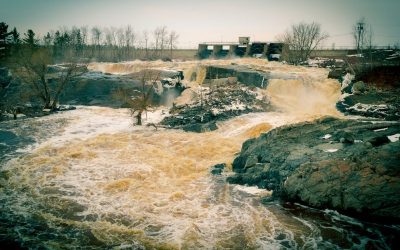Where History and Natural Beauty Collide in Spectacular Fashion Introduction Tucked away in the rugged landscape just southwest of Duluth lies one of Minnesota's most captivating photography destinations—Thomson Dam. Where the tumbling waters of the St. Louis River...
Places To Take Pictures In Carlton, Minnesota
The Duluth, Minnesota, and Superior, Wisconsin region, including the scenic North Shore, offers diverse photographic opportunities, and Carlton, Minnesota, presents its own unique charm. This small riverside community, established in 1881 as a Northern Pacific Railroad junction and serving as the seat of Carlton County since 1871, stands as a gateway to some of Minnesota’s most dramatic geological landscapes while preserving elements of the region’s rich railroad and hydroelectric heritage.
Situated at the edge of Jay Cooke State Park, Carlton offers photographers exceptional access to the wild, churning waters of the St. Louis River, where ancient slate and greywacke formations of the Thomson Formation create one of Minnesota’s most distinctive geological showcases. These 1.9-billion-year-old rock layers, with their dramatic tilted patterns and textural complexity, provide compelling foreground elements and leading lines for landscape compositions throughout the river gorge.
The iconic Swinging Bridge in Jay Cooke State Park, just minutes from downtown Carlton, serves as both a compelling subject and a unique vantage point for photographers. This 200-foot suspension bridge, originally built by the Civilian Conservation Corps in the 1930s and rebuilt several times since (most recently following the devastating floods of 2012), offers dramatic perspectives of the river below. The rustic design architecture of the current bridge reflects its 1934 predecessor, providing both historical interest and creative framing opportunities for landscape compositions.
A key photographic attraction near Carlton is the Thomson Dam, Minnesota’s largest hydroelectric facility. Completed in 1907 by Great Northern Power, the dam complex includes a 1,600-foot main structure and multiple supplementary dams that together impound the St. Louis River to create Thomson Reservoir. The facility features an impressive series of gate houses, a canal, forebay, and underground penstocks that supply a power plant located three miles downstream in Jay Cooke State Park. This engineering marvel, with its 72-megawatt capacity, represents an important chapter in Minnesota’s industrial development while offering photographers compelling structural elements amid the natural landscape.
The Thomson Dam area provides unique compositional opportunities where industrial architecture meets wilderness. Photographers can capture the geometric lines of the dam structures against the organic forms of the surrounding forest, or document the powerful interaction of water and human engineering where the St. Louis River drops 18 feet at the main dam. The reservoir itself creates mirror-like reflections on calm mornings, while the area below the dam features dramatic water movements through the rocky gorge.
For photographers interested in historical subjects, Carlton’s Pioneer Cemetery within Jay Cooke State Park preserves headstones dating back to 1887, offering atmospheric elements for environmental portraits or intimate landscape studies. The cemetery, with its weathered markers set against forest backdrops, tells visual stories of the area’s early settlers who arrived with the railroad and established communities like Thomson, which merged with Carlton in 2015.
Seasonal transformations make Carlton an ever-changing canvas for photographers. Spring brings powerful river flows as snowmelt surges through the gorge and over the dam, creating dramatic conditions for capturing the raw power of water. Summer reveals lush greenery along the hiking trails, while autumn transforms the mixed hardwood forests into a tapestry of reds, golds, and oranges that reflect beautifully in both the river’s calmer sections and the Thomson Reservoir. Winter presents perhaps the most magical photographic opportunities, as the river partially freezes into fantastical ice formations around the dam infrastructure and snow blankets the landscape, creating minimalist compositions of white against dark rock and industrial elements.
The quality of light in the river valley creates special conditions for photographers, particularly in early morning when fog often clings to the river’s surface and reservoir, or during the golden hour when sunlight filters through the trees and illuminates the textures of both the rock formations and the historic dam structures. The deep gorge creates dramatic shadow play throughout the day, rewarding photographers who visit the same locations under different lighting conditions.
Photographers exploring Carlton will find compelling subjects whether they focus on grand landscapes from the overlooks at Oldenburg Point, intimate details of the river’s geological features, the historical elements of the CCC-era structures, the industrial architecture of the Thomson Dam complex, or the seasonal transformations that continuously refresh the visual palette of this small but significant community. The extensive trail network provides access to viewpoints that remain relatively uncrowded compared to other North Shore destinations, allowing for unhurried composition and the quiet contemplation that often leads to the most meaningful images.
For photographers seeking to capture the essence of Minnesota’s diverse landscapes and the intersection of natural and human history, Carlton represents a vital story—where the power of water meets both ancient geology and industrial ingenuity in the dramatic river corridor that has shaped both the land and its communities for centuries.
Jay Cooke State Park
Where Wild Waters Meet Dramatic Stone The St. Louis River doesn't merely flow through Jay Cooke State Park—it rages, tumbles, and carves its way through some of Minnesota's most dramatic terrain. Just 20 minutes southwest of Duluth, these 8,938 acres of wilderness...


